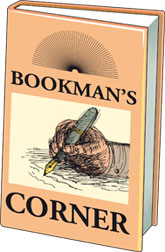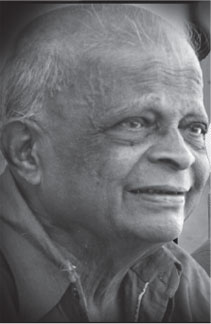|

Unqualified homage teeming with deficiencies
Reviewed by Jayantha Anandappa, Australia
Premasiri Khemadasa: Vicharathmaka Charithaapadanaya (A critical
biography) is intended to be a comprehensive critical commentary of his
life, works and his mission as a composer. To me the entire book sounded
more like an unqualified homage than a critical study. The book has
major deficiencies, factually incorrect information and serious flaws.
 |
|
Premasiri Khemadasa:
Vicharathmaka Charithaapadanaya
Author: Eric Iliyaparachchi |
The writer's approach in presenting the biography concurrently with a
commentary on the composer's works is a bold one. He has started well
using a timeline as the basis, but soon forgets the chronology and jumps
back and forth in discussing both the works and life often losing the
plot. The tone is to glorify the composer- almost with blind adulation.
The language style is tortuous and winding which makes reading a dull
exercise. Quoting great western composers and their great works
willy-nilly as if Khemadasa and his works are of the same ilk, is
another major drawback of the book. The narrative reaches comic levels
at times.
Observations
The following selected specific observations are made to illustrate
the typical shortcomings of the book: Biographical details do not refer
to a source. The account particularly on early days loses complete
credibility as it fails a simple litmus test- i.e.; The writer's failure
to record Khemadasa's long association with RA Chandrasena (Khemadasa
admirers seem to have a problem here).
It is well-known that Khemadasa while living always denied having
studied music formally under RA Chandrasena. Sunil Ariyaratne in his
series of books Gandarva Apadana had given objective evidence (including
a copy of Khemadasa's entry certificate and photographs) to show that
Khemadasa had associated Chandrasena at least for 6 years from 1953 to
1958 studying under him. Khemadasa had just turned 16 when he joined the
Chandrasena academy on 14 Feb, 1953.
I cannot accept how anyone committed to writing a serious study on
Khemadasa or his biography not being aware of this detail or ignoring it
deliberately. EI had quoted from the other books of Ariyaratne's
Gandarva Apadana series, but fails to acknowledge this vital fact. Using
a popular modern Sinhala slang, Eric had gone "shopping" for Khemadasa-
big time indeed. Sadly, this sets the tone and voice of the entire book.
Serious lapse
This very serious lapse erodes the credibility of all the consequent
accounts of Khemadasa's childhood and boyhood details which are
recounted as if the writer had been an observer at the scene.
Descriptions of how a small Khemadasa was tailing his mother with his
flute or how as a boy Khemadasa travelled ticketless in crowded trains
with the port labourers, playing his flute to entertain them (who see
the boy as belonging to their own class) and eventually being helped out
by a port labourer who buys him a platform ticket to exit the station-
all sound fictional. "A good script for a Hindi movie" a friend of mine
remarked wryly. I might add that some of those train trips surely must
have been to Maradana to attend the school of music of Chandrasena! The
writer seems to have tampered with the actual events.
Adulation reaches chronic proportions when the writer describes the
famous kidney transplant Khemadasa had to undergo. Not content with
glorifying Khemadasa, the writer now turns to venerate his kidney. This
is the translation from pages 298-9 a paragraph relating to the kidney
transplant: "The kidney too is a colourful fascinating human organ that
has its due place in the classical arts just as the human heart and the
liver.
During Shakespeare's time, the kidney was considered to epitomize
conscience and creativity. Cometh the Last Judgement Day! It is believed
that God will resurrect all the dead and examine the kidneys to assess
their good and evil deeds. If it is so then it can be concluded that the
beautiful organ (kidney) that was slowly waning inside Khemadasa's body
was the one that contained the very conscience of the Sinhala music and
its boundless creativity". Trust me I did not make up this.
Page 241 describes Khemadasa's personal traits: "Khemadasa used to
storm into the classrooms time and time again wrecking its atmosphere.
Bernstein's angry behaviour was a model for Khemadasa. On some days once
the lecturers complete their lectures Khemadasa would come to the
Foundation in the evenings and turn everything upside down".
This is not the place to discuss the prodigiously gifted Bernstein,
his occasional temper tantrums or his notoriously complex personality.
(Bernstein was mild at times, bisexual and suffered bouts of depression
during later years). If Bernstein or anyone else has a bad temper then
surely it is not a good personal attribute to emulate. There were also
similar irrelevant frivolous references to Debussy, Berlioz, Richard
Strauss, Mahler and others and the writer Hemingway.
Composer
Khemadasa emerged as a force in 1966, as a composer and a music
director for films with the film Senasuma Kothanada and blossomed after
Golu Hadawatha (1968). Prior to his emergence, a fair bit of ground work
had been already done by other composers both in the radio and in the
film media in trying to establish a format or an idiom for the creative
art song, film songs and even film theme music. EI had touched on the
previous work done by others on art song without critiquing.
There is some discussion on some of these composers (Samarakoon and
to a lesser extent Sunil Santha) and the state of music in the forties
and fifties, but his comments are superficial, selective and in general
seem to be driven by the motive to promote Khemadasa. The writer does
not seem to have a proper grasp or an appreciation of how the art song
(radio or gramophone) or the film songs or the film theme music evolved,
or the challenges composers faced prior to Khemadasa or their
contribution.
Khemadasa's commendable later efforts (the late seventies) in trying
to take the art song beyond the framework of the sarala geeya, is hardly
discussed. There is no proper evaluation of Khemadasa's contribution to
film theme music either, which was probably his forte.
Many musicologists consider his symphonic works such as Sinhala Aluth
Avurudda and Maha Muhuda as too imitative and lack balance of
instrumentation to be taken seriously. According to many, these works
not seminal by any means also show Khemadasa's limitations.
That he did not pursue in this path further is natural. It is not
logical to blame the lack of sponsorship or the disinterest of the art
circles for Khemadasa's retreat from these works (page 139). The writer
is perhaps right in saying that his symphonic efforts cannot be judged
by using western standards or a western yardstick, but again the
underlying motive is to glorify the musician than admitting the
limitations.
Cantatas
Comments on tone poems and cantatas surmount to lavish praise than
assessment of the musical merit. Khemadasa's contributions to musical
drama particularly his association with Sarachchandra has been
discussed. The last 100 odd pages are devoted to record data and
incidents relating to his operatic works, personnel who worked on his
orchestra, stories about Khemadasa, the Khemadasa Foundation, visit to
Prague, the kidney transplant and his last days. These details are a
mixed bag and are written in his usual stilted style making reading
tedious and boring.
Had the writer separated the biography from the works and treated
these as inter-related but discrete entities (as many biographers do)
the book would have been at least less convoluted and sympathetic to the
reader. Also his pretentious winding language style does not suit a
critical essay.
The book badly needs a timeline of the composer, references and a
list of Khemadasa's works in chronological order and a critical
discussion to illustrate the progressive evolution of Khemadasa's
musical odyssey as a composer.
It appeared as if the book is written to support the notion that
Khemadasa was entirely self-taught, self-made and as a composer he is on
par with any great composer from Bach to Bartok- something that any
average music lover will find difficult to agree. For the book to be
taken seriously, it needs a thorough revision and an honest and
objective approach from the writer.
***********
BOOK LAUNCH
Ajahn Chah Hamuduruvo
 Thilaka Kudahetti's latest book Ajahn Chah Hamuduruvo will be
launched at Dayawansa Jayakody Bookshop, Colombo 10 on June 21 at 10 am. Thilaka Kudahetti's latest book Ajahn Chah Hamuduruvo will be
launched at Dayawansa Jayakody Bookshop, Colombo 10 on June 21 at 10 am.
Ajahn Chah Hamuduruvo is the Sinhala translation of Paul Breiter's
Venerable Father, A Life with Ajahn Chah.
Kudahetti is the author of several other books including 'Nethata
Andunakse, Vathsunu Pavana, Durga Tharanaya, Neela Desa Pura, Sansara
Bandana, Vathura, Bharatha Yogin ha Manthrakaruvan Samaga Piramid
Bhuthayin Egipthy Sannasin ha manthrakaruvan samaga, and Kulagaei
Vilanaguva.
Ajahn Chah Hamuduruvo is a Dayawansa Jayakody publication. |

